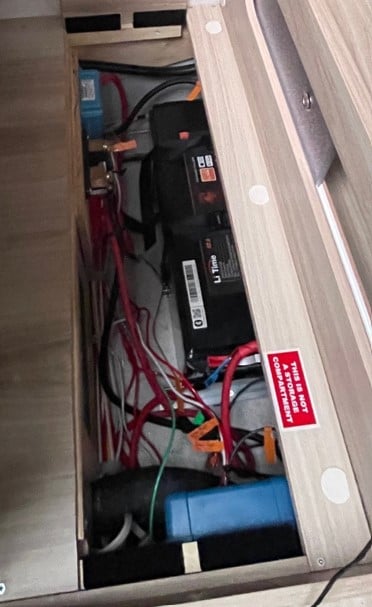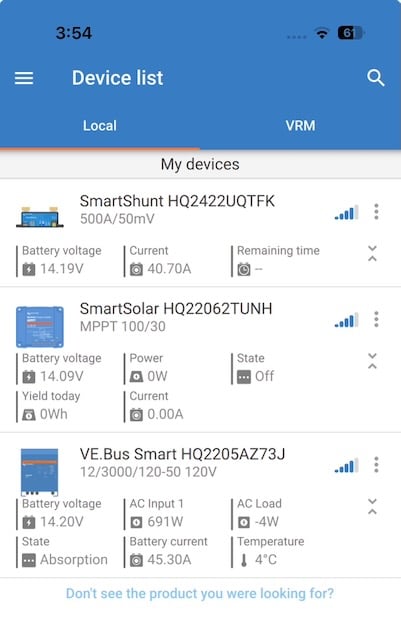Best Of
Re: Potential Battle Born Battery Issue
Think twice before buying Battle Born again...their parent company is a penny stock now...fading fast.
Lots of very good and affordable options out there (SOK, etc.), example: https://www.sokbattery.com/sk12v100h-sok-lithium-battery.html

Lots of very good and affordable options out there (SOK, etc.), example: https://www.sokbattery.com/sk12v100h-sok-lithium-battery.html

Re: Trip to Elkhart to See Truma
It's interesting that one of the heating elements looks larger than the other. This is different from other cutaway I recall seeing.
I wonder if that's a European model. Those have two different sized elements compared to US models.
I wonder if that's a European model. Those have two different sized elements compared to US models.
Re: Potential Battle Born Battery Issue
@Bayliss
There's a new reply from Battle Born on Facebook where they claim it's an intentional safety feature. If that's the case there would be no reason to make a change in newer batteries.
"To address questions that have recently surfaced about terminal heating and fastener design, it is important to highlight that what some observers view as a failure is a safety device working exactly as intended. The aluminum nut used in our 100Ah packs’ positive terminal is a purpose-built thermal failsafe. It is engineered so that the plastic deforms and disconnects when excess heat is present at the terminal."
Sounds a little suspect to me, but I'm no expert.
There's a new reply from Battle Born on Facebook where they claim it's an intentional safety feature. If that's the case there would be no reason to make a change in newer batteries.
"To address questions that have recently surfaced about terminal heating and fastener design, it is important to highlight that what some observers view as a failure is a safety device working exactly as intended. The aluminum nut used in our 100Ah packs’ positive terminal is a purpose-built thermal failsafe. It is engineered so that the plastic deforms and disconnects when excess heat is present at the terminal."
Sounds a little suspect to me, but I'm no expert.
Re: Potential Battle Born Battery Issue
The vid: Will Prowse opens the BB case to find an assembly process failure: the nuts attaching the positive "stud" were not tightened correctly. Instead of a nice low-resistance path for charging the battery, it has a loose connection turning it into a heater. If it is, e.g., ¼ ohm, when charging at 10 amps, that would be 25 watts heating up a small piece of metal. That could get pretty hot over sustained use.
It looks like the particular battery that he opened up was misassembled, as well as a few other reported failures.
I wish Will had included a manufacturing date code of some kind, to see whether there was a bad batch with wobbly terminals. If any of you have terminals which are loose, please reach out to BattleBorn for a response.
It looks like the particular battery that he opened up was misassembled, as well as a few other reported failures.
I wish Will had included a manufacturing date code of some kind, to see whether there was a bad batch with wobbly terminals. If any of you have terminals which are loose, please reach out to BattleBorn for a response.
Potential Battle Born Battery Issue
I posted this YouTube Video in the NuCamp Owners Facebook group and it was removed as being unrelated to NuCamp RVs. As many of you know, Will Prowse is respected and qualified. When I questioned the removal, I was removed from the Facebook group. Oh well. I have attached it here for information purposes only. Do with it what you will. I must say, it does give me pause with the two Battle Borns I have under my bed in my 400.
https://youtu.be/XP2yPY57Wjc?si=WD2KGPqWxXfwb7Jt
https://youtu.be/XP2yPY57Wjc?si=WD2KGPqWxXfwb7Jt
Re: question on Barefoot
Yes, definitely still being manufactured . Was at the NuCamp factory twice since September .Tabnero said:is this still being manufactured?
They are being manufactured in the NuCamp service center now , across the street from the NuCamp main factory . They pulled the Barefoot from the main manufacturing "line" and replaced it with the Haven . Since the Barefoot is a very low production build , they build them in a smaller scale over in the NuCamp service center for now . I saw several Barefoots in the "mid stages " of build /assembly recently . About 4-6 sitting outside half completed .
Re: 2025 320 BD - Cassette Flush Tank Volume
The cassette internal 'fresh water tank' is not used.

No reason to think nüCamp has changed the above for later model years.

No reason to think nüCamp has changed the above for later model years.
Re: HELP! Cirrus 620 winterized battery dead?
If you look at the SmartShunt numbers, it shows that 40.70A of current is moving into your battery. VE.Bus (Multiplus? Not sure - I don't have the equipment) shows 45.30A of current. The VE.Bus also shows "absorption" not "float" which means the battery isn't fully charged yet (but getting close).johnVT said:So I've been in touch with Jordan at NuCamp. I asked if it was OK to leave the camper plugged into shore power (with the battery heater engaged) through the winter, and he confirmed that it was.
So I plugged the camper in and all the Victron components reported a battery capacity between 14.10-14.20v. Guess the battery was OK after all? Anyways, it'll be plugged in for the winter...
Either something is using a heck of a lot of power in your camper or the battery was severely depleted and the converter is working pretty hard to recharge it.
If you're not using the camper over the winter and you're in a location (Vermont?) where the temperature is frequently below freezing, personally I would make sure that absolutely everything is shut off - zero power in/zero power out. If you have a way to keep it plugged into shore power your alternative would be to keep the Multiplus on but be sure to keep the battery heater on so your battery is protected when the charger kicks on when the ambient temperature is below freezing.
Re: 2025 Tab 360 w-Lithium Upgrade
Hi,
I have the 360CS where the OEM 100 ah battery is in the front. I changed out to the 230 Ah LiTime battery and placed it in the rear under the seat back, where it is placed for the non CS model. I am very happy with the performance of the battery. I consistently get 50 amps of charge out of the OEM WFCO charger.
I cut the cover (over the entire rear area) into two sections. One that would stay over the AC and a second section over the area where I relocated the battery. Because you really do not need to go in there often, I thought it was fine. Instead of screws, I placed velco around the perimeter to hold the covers in place, but in reality..I think it would be fine w/o screws or velcro. The cover is recessed and not going any where.
I'm also on the fence to add an inverter or just use a Ecoflow or Jackery to power a few indoor kitchen items . The only thing I want to heat is hot water in a kettle and run the microwave for very short periods of time. Well within the the capability of those units . I have an 2000W Ecoflow. I installed an inverter and transfer switch when I had our 320 and although very convenient, I'm not sure all the work and expense is really needed for the little non shore power we need.
All the AC circuits come out of the WFCO. There is an extra slot you could use to place an outlet in the kitchen area. I would guess the wattage of a Blackstone is in the same range of a hot water kettle (1500 or so) but would be run much longer for cooking than just heating water up. Here are a few photos that might be helpful.
On a side note, I've read it's not a good idea to mix different brands of LiPhos. batteries. I ended up selling my 100 Ah BB.

I have the 360CS where the OEM 100 ah battery is in the front. I changed out to the 230 Ah LiTime battery and placed it in the rear under the seat back, where it is placed for the non CS model. I am very happy with the performance of the battery. I consistently get 50 amps of charge out of the OEM WFCO charger.
I cut the cover (over the entire rear area) into two sections. One that would stay over the AC and a second section over the area where I relocated the battery. Because you really do not need to go in there often, I thought it was fine. Instead of screws, I placed velco around the perimeter to hold the covers in place, but in reality..I think it would be fine w/o screws or velcro. The cover is recessed and not going any where.
I'm also on the fence to add an inverter or just use a Ecoflow or Jackery to power a few indoor kitchen items . The only thing I want to heat is hot water in a kettle and run the microwave for very short periods of time. Well within the the capability of those units . I have an 2000W Ecoflow. I installed an inverter and transfer switch when I had our 320 and although very convenient, I'm not sure all the work and expense is really needed for the little non shore power we need.
All the AC circuits come out of the WFCO. There is an extra slot you could use to place an outlet in the kitchen area. I would guess the wattage of a Blackstone is in the same range of a hot water kettle (1500 or so) but would be run much longer for cooking than just heating water up. Here are a few photos that might be helpful.
On a side note, I've read it's not a good idea to mix different brands of LiPhos. batteries. I ended up selling my 100 Ah BB.

Re: three year old T@B 400 sealant issues?
Not with our 2019 400 @Larami, so far. I did find a sealant check notice from the factory from 2020 that is attached. The areas I have heard about with sealant have been the small window in the door, and the caulk around the porthole windows. Some have reported the top area of the front window leaking. All are pretty easy to remedy.
Enjoy,
QH
Enjoy,
QH







